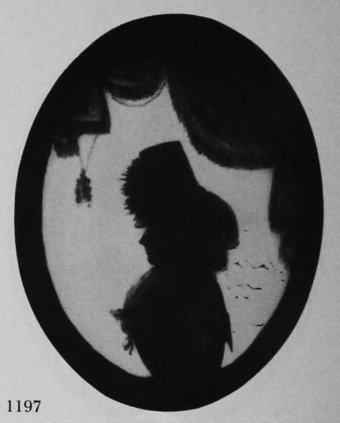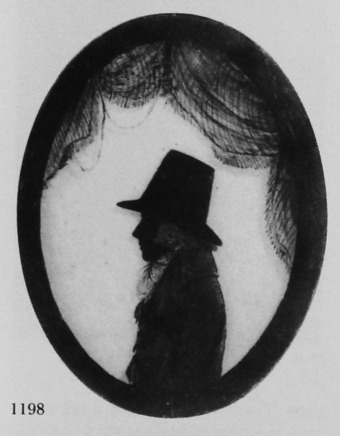Spornberg, Jacob (McKechnie Section 3)
See Section Six for main entry
Spornberg painted a few profiles, in black, on the under surface of flat glass. This type of work is not specifically mentioned in any of Spornberg's known advertisements (see Section Six), which refer only to his 'Etruscan' profiles (that is, profiles painted in line on a red base colour against a black background). One of the black profiles on glass illustrated in this Section is backed with contemporary orange paper in the `anti-Etruscan' style, which seems to have been practised mainly by Bath artists of the 1790s, and it is possible that other examples may have been backed in this fashion. Spornberg was no doubt competing with Charles Rosenberg (q.v.), who had painted `Anti-Etruscan' silhouettes in retaliation against the 'Etruscan' (red against black) silhouettes which Spornberg had originally painted. Five silhouettes painted in black on flat glass were formerly in the Wellesley collection. One of these, now owned by Mr. J. A. Pollak, is illustrated.
1196
The style of these profiles (most of them in half-length) is different from that of the profiles described in Section Six, and their format is larger, some being housed in oval hammered brass frames of the size used by Rosenberg. The edge of the flat glass shows a deep black line, and often the top of the oval is filled with a ‘looped-curtain' design, of the type used by some other artists, especially on full-length work. There is no bust-line termination. Both the looped curtain and the sitters' costume are shown by hatching against a fingerprinted base; a needle was used to highlight the hair. The face is in solid black.
Jackson (Dictionary) records a conversation piece, apparently painted in black on flat glass, showing two men, one seated and one standing, but she does not say whether this was inscribed or labelled.
Typical signatures (in Spornberg's hand) from the 1582
reverses of his silhouettes on glass are J. Spornberg fecit, No. 22, Orange Grove, Bath' and J. Spornberg fecit, No. 2, Lilliput Alley, North Parade, Bath'.
Ills. 1196- 1198

Unknown man, possibly a cleric
Silhouette painted on flat glass, with black oval border
c. 1792-93
5 x 4in./128 x 102mm.
Frame: oval, hammered brass
Inscribed on the reverse, ‘J. Spornberg fecit, No. 2, Lilliput Alley, North Parade, Bath.’
J. A. Pollak collection

Unknown woman
Silhouette painted on flat glass
c. 1792-93
5 x 4in./128 x 102mm.
From Weymer Mills, ‘One Hundred Silhouettes from the Wellesley Collection’ (1912), by courtesy of the Oxford University Press

Unknown man
Silhouette painted on flat glass, backed with orange chalk-surfaced paper
c. 1792-93
5 x 4in./128 x 102mm.
Frame: oval, hammered brass
Signed on the reverse, ‘J. Spornberg fecit, No. 22, Orange Grove, Bath.’ The shadow of the silhouette is thrown onto the orange paper.
Author’s collection
